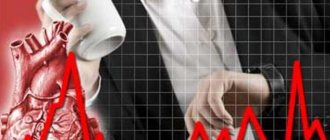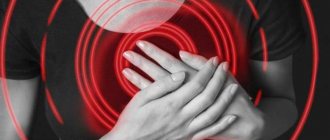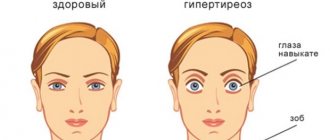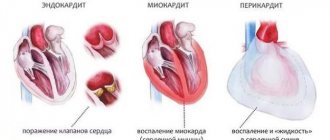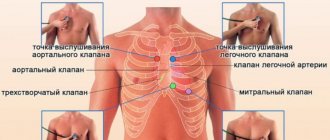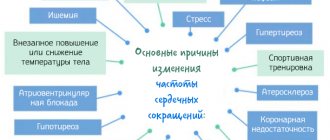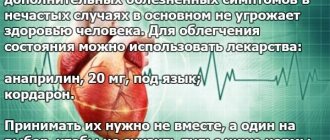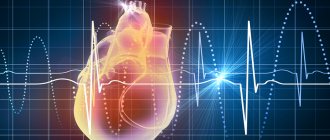Tachycardia during ARVI (rapid heartbeat during a cold)
Tachycardia is an increase in heart rate (HR) above the physiological norm.
The normal heart rate is 60-90 beats per minute. Typically, tachycardia during ARVI is not associated with pathology of the cardiovascular system. One of the symptoms of ARVI is fever. When body temperature rises, the heart rate increases in the ratio: 10 beats per minute per 1 degree Celsius.
Tachycardia during ARVI should not give cause for concern; as a rule, when the temperature decreases, the heart rate normalizes. The main task is to distinguish tachycardia caused by cardiovascular failure during ARVI and requiring special treatment.
Classification, causes
There are physiological and pathological tachycardia.
Physiological occurs during physical activity and stress. At the same time, the level of adrenal hormones increases, which leads to an increase in heart rate.
Physiological tachycardia is an absolute norm for the body and goes away with the elimination of the provoking factor.
Pathological tachycardia occurs at rest and is a marker of cardiovascular, endocrine diseases, and inflammatory processes.
Its cause may be:
- Hyperthyroidism;
- Anemia;
- Heart defects;
- Myocarditis;
- Myocardial dystrophy;
- High blood pressure;
- Acute blood loss;
- Pheochromocytoma;
- Purulent processes (abscesses, phlegmon, peritonitis, meningitis);
- Dehydration with prolonged diarrhea, vomiting.
Tachycardias are divided into two large groups:
- Supraventricular;
- Ventricular
Supraventricular tachycardia
This definition means three or more consecutive contractions of the heart with a frequency above 100 per minute, and the cells of the sinus node, atrial myocardium and atrioventricular junction participate in the process.
In turn, supraventricular tachycardias are classified into:
- Sinus tachycardia;
- Sinoatrial reciprocal tachycardia;
- Atrial tachycardia (including atrial flutter);
- AV nodal reentrant tachycardia;
- Tachycardias with pre-excitation syndromes: orthodromic reciprocal tachycardia and antidromic reciprocal tachycardia;
- Atrial fibrillation.
Ventricular tachycardia
This type of violation includes:
- Paroxysmal monomorphic ventricular tachycardia;
- Fascicular left ventricular tachycardia;
- Continuously relapsing ventricular tachycardia;
- Polymorphic ventricular tachycardia.
As can be seen from the definitions, these forms differ in the source of pulse propagation.
The connection between flu, colds and heart health
ARVI, like influenza, occurs when the body is infected with viruses. Clinical manifestations of ARVI:
- Increased body temperature;
- Weakness;
- General malaise;
- Runny nose;
- Nasal congestion;
- Sore throat;
- Aches in the joints.
With influenza, the course of the disease is characterized by high (>38 C) temperature from the first days of illness, headaches, and pain in the superciliary area.
For more accurate diagnosis, there are currently rapid flu tests that can be purchased at pharmacies.
Causes of tachycardia during ARVI
Intoxication caused by the pathogenic effect of the virus on the body can lead to rhythm disturbances:
- Fever. An increase in body temperature of 1 degree leads to an increase in heart rate by 10 beats per minute.
- Dehydration.
It develops with the addition of vomiting, diarrhea (tachycardia with influenza), and with limited drinking (poor appetite). Under conditions of fluid deficiency, the volume of circulating blood decreases.As a result, the heart muscle needs to strengthen its work to ensure normal blood flow to tissues and organs.
Treatment
Treatment of colds comes down to the following:
- Abundant fluid intake, special solutions for oral rehydration. If it is impossible to drink liquids in large volumes (with the urge to vomit, for example), intravenous administration of saline solutions will be required.
- Rinsing the nasal passages with saline solutions.
- Antiviral drugs (for influenza).
- At temperatures above 38.5 C - antipyretics.
- Symptomatic therapy depending on the manifestations of ARVI: vasoconstrictor drops in the nose for a runny nose, gargling with antiseptic solutions for pharyngitis, expectorant medications for coughs.
- Painkillers for headaches. Typically, antipyretics have an analgesic effect.
- If the temperature persists for a long time, you must consult a doctor and take a chest x-ray to exclude or confirm bronchitis or pneumonia.
- Taking vitamins and microelements is of an auxiliary nature.
If a patient is diagnosed with tachycardia, it is important to follow a regimen that will prevent an even greater increase in heart rate:
- Reduce physical activity;
- Maintain bed rest;
- Avoid psycho-emotional shocks;
- Consume liquid in large quantities;
- Ventilate the room regularly.
As for tachycardia, it is first necessary to establish the cause of the rapid pulse. For example, with hyperthyroidism, treatment will be reduced to a drug reduction in the production of thyroid hormones.
For patients with psychological problems and disorders, sedatives and antidepressants are helpful. Sessions with psychotherapists often help calm the nervous system and normalize heart rate. In this case, aromatherapy sessions and meditation have a beneficial effect.
Herbal tea with mint or milk also calms and normalizes the pulse.
If you experience a high heart rate, the following recommendations may help:
- Rinse your face and neck with cool water;
- Perform deep breathing movements while holding your breath while inhaling;
- Make pressing movements on the eyeballs;
- Massage movements in the projection of the sinocarotid sinus (when turning the head to the side in the fossa between the neck muscles).
Drug treatment can only be prescribed by a doctor (generalist, cardiologist). It will largely depend on the type of tachycardia.
Thus, sinus tachycardia, for example, does not require special treatment. Therapy in this case is aimed at eliminating the provoking factor (quitting smoking, drinking alcohol, coffee, strong tea, treating fever - in the case of ARVI).
Medicines are prescribed in cases where objective discomfort occurs and angina pectoris worsens. In this case, drugs from the group of β-blockers, calcium antagonists, and digoxin are prescribed.
To stop attacks of atrial tachycardia, intravenous administration of class I and class III antiarrhythmic drugs will be required, and transesophageal electrical stimulation of the atria is also possible.
As you can see, there are many ways to treat high heart rate; they should be prescribed by competent specialists.
Complications
Complications arise in the presence of initially pathological tachycardia due to a certain pathology. When acute respiratory infections occur, an increase in heart rate is superimposed on an already existing tachycardia.
This threatens the development of the following complications:
- Hypertensive crisis;
- Rhythm failure;
- Myocarditis.
Symptoms of myocarditis can sometimes occur under the guise of an acute respiratory viral infection: high fever, general malaise, weakness, aching joints. Shortness of breath and tingling in the heart area should alert you.
If the development of cardiac pathologies is suspected against the background of ARVI, an additional examination is prescribed:
- Blood and urine tests. This helps in identifying a viral infection as the cause of tachycardia.
- A biochemical blood test helps diagnose disorders of other organs and systems.
- Electrocardiogram. Assists in setting the type of tachycardia
- Ultrasound of the heart - if myocarditis is suspected
Prevention of tachycardia during colds
A diet with the exclusion of spicy, fatty, fried foods, limit the intake of coffee and caffeine-containing drinks. Caffeine stimulates the nervous and cardiovascular systems, provokes tachycardia and increased blood pressure.
Combined with an increased heart rate due to a fever, this can negatively affect your heart function and overall health.
During the epidemic, limit visits to places with large crowds of people, wear a medical mask, and rinse your nose with saline solutions.
Taking immunomodulators is questionable. It is also necessary to observe a work-rest schedule, regularly ventilate the premises, humidify the air, especially during the heating period, regularly be in the fresh air, and play sports.
Quitting smoking, drinking alcohol and treating underlying diseases that cause tachycardia (hyperthyroidism, pheochromocytoma, anemia, purulent-inflammatory processes) are important.
Source: https://davlenie.guru/tahikardiya-pri-orvi.html
Tachycardia and sports
“By exercise and abstinence the greater part of the people can get along without medicine.” It sounds quite modern, although the words belong to the Enlightenment writer and politician Addison Joseph. Please note that we are talking about physical education, not sports. When talking about tachycardia, it is necessary to distinguish between these concepts. So, tachycardia and sports - are they compatible?
Great sport and tachycardia
Today, big sport has turned more into a business. This is a way to earn big money at the cost of your own health. Huge overloads subsequently result in big problems. The heart, which works hard in professional athletes, can suffer especially severely.
During training, the heart experiences a huge need for oxygen. To provide it for itself, the heart muscle begins to contract at an accelerated rate. The heart rate reaches prohibitive numbers. The myocardium wears out quickly. In addition to physical activity, the athlete experiences stress, which affects the heart no less negatively. Heart neurosis is one of the consequences of professional sports, especially among cyclists.
To avoid the fatal consequences of intense physical and emotional stress, athletes undergo annual medical examinations. When tachycardia is detected, doctors put an end to the athlete’s career. No victories or awards are worth his life. The desire for great sporting achievements and tachycardia are incompatible.
What sports can you do if you have tachycardia?
The standard set of activities that the cardiologist will list for you is swimming, cycling, game sports, and skiing. Recommends walking and jogging. Such activities can rather be called physical education. Why are these particular types of physical activity allowed for tachycardia?
Swimming
It is well known that water calms a person. Swimming is fun and relieves stress. Slow swims will lift your spirits and relieve fatigue. Here's what medicine says about the benefits of this sport:
- Water has a beneficial effect on the central nervous system, balancing the processes of excitation and inhibition. This happens due to the fact that during movement, water, flowing around the body, has a soft massage effect on the skin and muscle nerve endings. As a result, neurosis, which is often the cause of tachycardia, may recede.
- The heart and blood vessels receive no less benefit. Keeping the body in a suspended horizontal state, cyclical muscle tension, uniform deep abdominal breathing and water pressure on the subcutaneous bed makes the heart work more efficiently - the amount of blood pumped per contraction increases, and the condition of the blood vessels improves. Regular swimming reduces the heart rate to 60 beats per minute, and the heart begins to work economically and powerfully.
- Swimming also trains the respiratory system. As a result, ventilation of the lungs and the volume of air absorbed by them increases, and the blood consumes more oxygen.
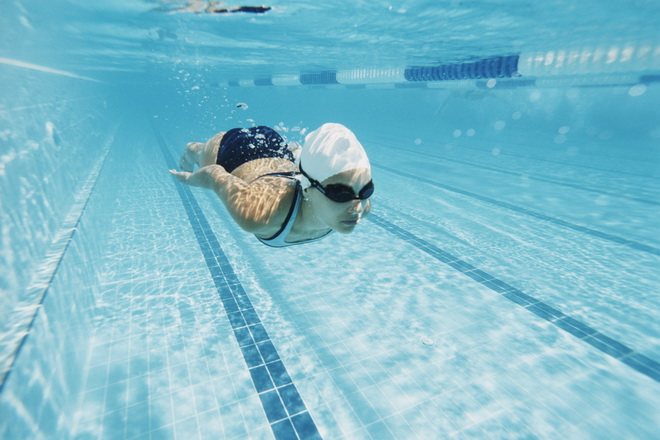
This is not about competitions and achievements, but about swimming for fun.
Biking
Is it possible to engage in cycling if you have tachycardia? Need to! Cycling is no less fun than swimming. This is the best way to relieve nervous tension and recharge with positive emotions. Skating provides moderate cardio exercise. The heart muscle is strengthened, vascular tone increases, the level of “bad” cholesterol decreases, and the blood is enriched with oxygen.
Skiing is a salvation for the heart
Light frost, a beautiful winter park or forest, good company - what could be better on a winter Sunday morning! In addition to positive emotions, a ski trip will benefit the entire body, and most of all the heart. During skiing, blood circulation improves, especially in small vessels. They expand, allowing blood to move faster and in greater volume. The strength of heart contractions increases without causing an increase in blood pressure. Even a short walk reduces the heart rate to 60 - 70 beats per minute. Ventilation of the lungs and gas exchange improve, the blood is more saturated with oxygen. Those who ski regularly quickly forget about tachycardia and other heart ailments.
Game sports
Table tennis and volleyball are games that bring not only strength to the body, but the joy of communication. Volleyball helps strengthen the musculoskeletal system and trains the heart. Playing in a team develops reaction, discipline, and eliminates fears and complexes. Variable load and training of almost all muscles of the body improves vascular tone and lung function.
Walking and running
There is no need to talk about the benefits of walking. Daily leisurely walking for 30 to 40 minutes is an element of the treatment of heart disease. But the benefits of running during tachycardia are a controversial issue. Running is the most dangerous type of physical activity for tachycardia. The heart, already working in an abnormal mode, can react with a serious disorder that threatens life. During exercise, so-called jogging tachycardia may begin. They are typical for those who suffer from the paroxysmal form of this syndrome. It is especially scary if the attack is expressed by a run of ventricular tachycardia, which can turn into fibrillation of the ventricles of the heart and cause sudden cardiac death. Sinus tachycardia is less dangerous in this regard, when an increase in heart rate is a type of physiological norm.
Running can be practiced only in the form of light jogging with periodic rest. As you can see, the call to “run from a heart attack!” is insolvent. Light jogging should not be started immediately. You need to gradually move on from walking to them, gradually increasing its pace. Today, cardiologists recommend jogging no more than 3 times a week.
Cardio training
Cardio training can be classified as physical therapy (physical therapy), which is indicated not only as a prevention of heart disease, but also as a means of rehabilitation after myocardial infarction. Exercises for tachycardia can be done as regular exercise or on exercise machines. Therapeutic and preventive gymnastics is divided into complexes, which can be different and depend on the patient’s cardiac pathology. For prevention, cardio training should be done by everyone who moves little and has a sedentary job. And it doesn’t matter at what age sports activities begin.

Cardio training also includes those sports that are already listed above. To these you can add Nordic walking and moderate exercise. Today, any self-respecting fitness club must have a trainer who can develop an individual training program. The basic principles are dosed exercise depending on the heart rate. Its maximum indicator depends on age and individual characteristics and is calculated using a special formula. The load on the simulator - bicycle or treadmill - should be such that the heart rate does not exceed 60 - 70% of the maximum values. For self-study, a heart rate monitor is very useful.
Yoga and Pilates
Yoga and Pilates are classified as static fitness exercises. For tachycardia, this is an ideal way to train your body. Yoga aims to achieve balance between physical and spiritual well-being. This is an excellent way to relieve stress, get rid of neurosis, improve blood circulation and lower blood pressure. In addition, the benefits of yoga for the heart include the following:
- cholesterol levels decrease;
- the blood is saturated with oxygen;
- the functioning of the immune system improves.
One of the foundations of gymnastics is proper breathing. Scientists conducted a study of the effect of yoga on the condition of patients with paroxysmal tachycardia. The result revealed the following:

- participants had a noticeable decrease in the number of fibrillations;
- the frequency of paroxysms has decreased;
- general health has improved.
Today, yoga is recommended as therapeutic exercise for tachycardia.
Pilates, like yoga, brings quite tangible benefits. It is not an aerobic exercise, but rather a static-dynamic one. Indications for Pilates include diseases of the cardiovascular system. The exercises are gentle - the maximum heart rate during exercise should not be more than 100 beats per minute, otherwise the workout should be stopped.
Other types of physical activity for tachycardia
So, we found out whether it is possible to play sports with tachycardia. What about other physical activities? There are many of them in our lives and they are not limited to physical education. These include housework, too hot a bath, and sex. Simple housework usually does not cause an attack of arrhythmia or tachycardia. You need to be careful only if paroxysmal tachycardia often makes itself felt or after serious illnesses.
The bath is a separate type of stress on the heart. If you have tachycardia, it is contraindicated to stay in a very hot steam room for a long time. But if the temperature does not exceed 90°C, and the time spent in it is no more than 10 minutes, then it will bring nothing but benefits for the heart. At moderate temperatures, blood vessels dilate and blood circulation improves. You should not visit the bathhouse if you have paroxysmal tachycardia or if you have hypertension.
Many men (very suspicious people), having once experienced an attack of tachycardia during sex, begin to fear a repetition of the painful sensations. Fear results in a man being afraid to have sex. Against this background, neurosis can develop, which can lead to a disorder of sexual function. On the other hand, sex is one of the best cardio workouts, it helps strengthen the cardiovascular system. However, repeated painful attacks of tachycardia require comprehensive medical examination and treatment; they can be a signal of serious diseases - neurosis, vegetative-vascular dystonia, cardiac pathology.
And in conclusion, the words of the Italian physiologist Angelo Mosso are perfect: physical education can replace many medications, but none of them can replace physical education. A person who constantly plays sports has a chance to never know what pathological tachycardia is.
Why can you experience heart palpitations when you have a cold?
- Causes of increased heart function
- Actions in case of such violation
Some people may experience heart palpitations when they have a cold. And few people attach special importance to this condition.
However, if, in addition to the other unpleasant symptoms present, such as high temperature, cough and fever, the heartbeat also increases during a cold, the person’s condition begins to deteriorate even more.
Therefore, it is important to monitor your condition during a viral disease and pay attention to changes in heart rhythm.
Causes of increased heart function
In most cases, the rapid rhythm of the heart muscle is due to the fact that the infection inside the body is not treated in a timely manner and gradually begins to affect the vascular and cardiac systems.
In this case, such a symptom is considered an unpleasant complication arising from a disease that has acquired an advanced form.
To avoid this condition and prevent increased stress on the heart muscle, it is necessary to consult a doctor in time as soon as the first suspicion of a respiratory viral infection appears.
A rapid heartbeat can accompany acute respiratory illnesses. This is due to the fact that the body is attacked by pathogenic bacteria. And if in such a situation you do not begin to take the necessary therapeutic actions, an increased heart rate during a cold can provoke serious disturbances in the functioning of the nervous system.
A rapid pulse and accelerated heartbeat can also be observed when the temperature rises during a cold and the human body faces increased stress. Tachycardia can also occur in cases where the human body encounters the following conditions during an infectious disease:
- fever:
- dehydration;
- high blood pressure;
- prolonged ARVI;
- severe form of influenza.
When the body encounters an infection, the immune system begins to actively produce antibodies, which are carried through the bloodstream and help fight the virus. As a result, the entire cardiac system begins to work in an enhanced mode.
The heart rate increases and the rhythm becomes faster. Due to this, antibodies approach the foci of infection much faster. Thanks to accelerated blood circulation, pathogenic bacteria, toxins and viral breakdown products begin to be eliminated from the body.
The body is detoxified.
The heart rate during a cold is directly related to how high your body temperature rises. Each subsequent degree causes ten heart beats per minute. And the more complex the viral disease is, the stronger the tachycardia becomes.
This condition is considered extremely dangerous, as the human body weakens, it becomes difficult for it to cope with the load, and the risk of a heart attack increases.
Actions in case of such violation
When, during a cold, a person experiences an increase in heart rate and rapid work of the heart muscle, there is no need to panic.
It is necessary to observe complete bed rest and also drink enough fluids during the day. Do not forget about taking antipyretic drugs.
Such medications can not only defeat the infectious agent, but also normalize temperature indicators.
If rapid heartbeat during a cold occurs against a background of normal temperature, then antipyretics are replaced with antiviral drugs. They destroy pathogenic bacteria and block the development of the infectious process. Additionally assigned:
- vasoconstrictor medications;
- antioxidants that improve blood circulation in the body;
- cardiac glycosides;
- beta blockers to reduce stress.
Also, during treatment you should adjust your menu. You should avoid fatty and spicy foods, as well as drinks that contain caffeine. It is imperative to take complexes that strengthen the immune system. Provide your body with a good night's rest, which should last at least eight hours.
You should engage in moderate exercise throughout the day. This will not only normalize the functioning of the heart muscle, but will also increase the body’s resistance to pathogenic bacteria.
Another important point for a cold that occurs with the onset of a feverish state is sufficient compliance with the drinking regime. Against the background of dehydration, the volume of blood flow decreases, as a result of which the cardiovascular system works in an enhanced mode.
Source: https://serdechnic.com/serdtsebienie-pri-prostude.html
Causes of increased heart function
In most cases, the rapid rhythm of the heart muscle is due to the fact that the infection inside the body is not treated in a timely manner and gradually begins to affect the vascular and cardiac systems. In this case, such a symptom is considered an unpleasant complication arising from a disease that has acquired an advanced form. To avoid this condition and prevent increased stress on the heart muscle, it is necessary to consult a doctor in time as soon as the first suspicion of a respiratory viral infection appears.
Tachycardia after a cold
A rapid heartbeat with a cold sometimes worries people after an illness. As a result of acute respiratory viral infections, the patient often suffers from cough, fever and other unpleasant symptoms.
If these problems are not treated, the infection affects the cardiovascular system, which is manifested by an increase in the rate of heart contraction. Sometimes this symptom is also troubling with the flu. This can be caused by various reasons.
What causes tachycardia during ARVI?
Respiratory infections are caused by viruses. They spread to the upper respiratory tract and cause inflammatory processes. At the same time, a person’s body temperature rises, swelling and other unpleasant symptoms occur. Such diseases are usually transmitted by airborne droplets. If you use common household items, you can become infected with pathology.
This condition is usually accompanied by:
- runny nose and nasal congestion;
- sneezing;
- increased body temperature;
- weakness of the body;
- dry cough.
In some cases, the manifestations of diseases are not immediately noticeable. When you have a cold, your heart rate often increases, which is considered an unpleasant complication.
Acute respiratory viral infections affect many. This is a common occurrence in the autumn-winter period. If you seek help from a doctor correctly, you can avoid serious complications. The specialist prescribes effective and safe treatment methods that will significantly improve a person’s health.
Tachycardia is usually considered not a separate disease, but a symptom of vascular pathologies such as heart failure or myocardial infarction.
The problem often accompanies acute respiratory infections due to exposure to pathogenic bacteria. Frequent heartbeat can cause disturbances in the functioning of the nervous system, neuroses and other complications.
The main causes of problems with colds
Tachycardia occurs under the influence of various factors. This usually happens if:
- the body lacks oxygen;
- a person is exposed to excessive emotional and physical stress;
- the functions of the immune system are impaired;
- the patient suffered from diseases of the cardiovascular system;
- have used many medications for a long time;
- a person abuses alcoholic beverages;
- the body has been exposed to pathogenic microorganisms.
Often with viral infections, there is an increase in heart rate, although the body temperature does not increase. In this case, the person suffers from chills and other symptoms of the disease.
The presence of tachycardia during a cold may be accompanied by high fever and other manifestations of the disease.
It is believed that the development of tachycardia occurs under the influence of the following factors:
- With colds, the functions of the immune system decrease. Because of this, viruses penetrate deep into the body and interfere with its functioning. At the same time, the functions of the heart are also impaired.
- Colds are accompanied by dysfunction of the nervous system. Because of this, sensitivity increases and nerve impulses become more frequent.
- Viral infections cause exacerbation of other diseases. If a person has a history of heart disease, his condition worsens significantly.
A cold is accompanied by symptoms common to cardiac diseases, such as shortness of breath, weakness and increased fatigue, a feeling of lack of air, and impaired blood flow to the brain.
An increased heart rate during a cold cannot be ignored. It can cause serious complications, so you should seek medical help.
Features of diagnosis and treatment
With a cold, fever and rapid heartbeat are quite common. To confirm the diagnosis, the doctor prescribes a number of examinations, including:
- electrocardiography to determine the type of tachycardia and the degree of heart rhythm disturbances;
- a general urine and blood test to confirm that a viral infection is developing in the body;
- Magnetic resonance imaging of cerebral vessels. It is prescribed to assess the condition of the Central nervous system.
After confirmation of the diagnosis, treatment begins with drugs to destroy the viral infection. Only after eliminating this problem can we begin to normalize the heart rhythm. This approach is due to the fact that the virus provokes repeated symptoms and all therapy will be ineffective.
Treatment is usually carried out with:
- Antipyretics. They help destroy the pathogen and normalize temperature. When tachycardia is observed during a cold without fever, such drugs are not used.
- Antiviral drugs. They fight the infectious process and get rid of dangerous bacteria.
- Vasoconstrictor medications.
- Beta blockers to reduce the effects of stress hormones.
- Antioxidants to improve blood circulation.
- Cardiac glycosides.
These drugs should be prescribed by your doctor, as if used incorrectly they can cause a number of unpleasant consequences.
To ensure that the heart rate during ARVI remains within normal limits, it is necessary:
- Avoid spicy and fatty foods and caffeinated drinks;
- do not visit public places, but stay at home in bed;
- take medications that strengthen the functions of the immune system;
- do morning exercises and physical therapy. With the help of moderate loads, heart function is normalized, the body's resistance to pathogenic bacteria increases;
- Get enough rest, sleep at least eight hours a day.
Tachycardia during a cold is considered a rather dangerous problem. To normalize the heart rate, it is necessary to get rid of the virus. The help of a doctor will help quickly bring your health back to normal.
Increased heart rate during a cold - should you worry?
Tachycardia can appear as one of the symptoms of a cold. It is an acceleration of the heartbeat, and can lead to serious consequences. Therefore, you need to get rid of the symptom as soon as possible by starting a course of treatment for ARVI.
Causes
The causes of tachycardia during ARVI are being studied to this day, because such a symptom provokes the development of complications associated with the functioning of the cardiovascular system.
The cause of an increase in heart rate may be features of the course of ARVI, such as:
- Fever . An increase in body temperature almost always accompanies the course of ARVI. The functioning of the cardiovascular system depends in a certain way on body temperature. For every 1 °C increase, the heartbeat accelerates by 10 beats. per minute This feature of the body allows one to accelerate the transport of protective antibodies to the site of infection by the virus. Also, a high pulse allows you to quickly remove metabolic products of microorganisms that are toxic.
If a cold is accompanied by a purulent-inflammatory process, the pulse may increase significantly, which is also a protective reaction of the body. If the heart rate is up to 110 beats. per minute, no need to worry.
- Caffeine overdose . During the course of a cold, it is recommended to drink a lot of fluids, especially hot ones. Therefore, patients often overdo it with the amount of hot tea they drink, which also contains caffeine, and therefore can increase heart rate.
- Dehydration of the body . If you do not provide the patient with plenty of fluids, he may become dehydrated. This occurs due to high temperature, which causes sweating. When there is little fluid in the body, there is also less blood in the vessels, and its viscosity increases. To ensure normal blood flow to the organs, the heart has to beat faster to “drive” it around the body.
In this case, tachycardia is manifested by an accelerated, but not increased heartbeat. The pressure in the arteries decreases, which makes the picture of dehydration even worse.
Possible complications
In addition to the physiological characteristics of the course of a cold, tachycardia during ARVI can also be provoked by other reasons. Among them are:
- Pathogenic microorganisms penetrate the internal organs, often the heart. Their activity disrupts the functioning of the organ, which, in fact, causes tachycardia. One such disease is myocarditis, the symptoms of which make the patient think that it is just a cold. When the heart muscle becomes inflamed, a person’s temperature rises, the pulse quickens, weakness, fatigue and body aches appear, shortness of breath and stabbing pain in the area of the heart.
- Exacerbation of other diseases. The presence of diseases of the cardiovascular system, such as hypertension, can provoke tachycardia and significantly increase blood pressure. In this case, it is necessary to take antipyretic drugs. You should also reduce your blood pressure with a short-acting antihypertensive agent: Captopril, Furosemide, etc.
Source: https://med-perevozka.ru/lechenie/tahikardiya-posle-prostudy.html
Rapid pulse and heartbeat: normal or alarming signal?
Have you been struggling with HYPERTENSION for many years without success?
Head of the Institute: “You will be amazed at how easy it is to cure hypertension by taking it every day.
The pulse directly depends on the heart rate. The higher this indicator, the more the heart is loaded, the faster it pumps blood and oxygen. What can cause a rapid heartbeat and how dangerous is it? Let's try to figure it out.
Heart rate indicators
The pulse is characterized by several values.
Our readers successfully use ReCardio to treat hypertension. Seeing how popular this product is, we decided to bring it to your attention. Read more here...
Frequency – number of beats per minute. It must be measured correctly. The pulse in a sitting position and in a lying position may differ. Therefore, use the same posture when taking measurements, otherwise the data obtained may be misinterpreted. Also, the frequency increases in the evening. Therefore, do not be alarmed if its value is 75 in the morning and 85 in the evening - this is normal.
Rhythm - if the time interval between adjacent beats is different, then arrhythmia is present.
Filling - characterizes the difficulty of detecting the pulse, depends on the volume of blood distilled by the heart at one time. If it is difficult to palpate, this indicates heart failure.
Voltage – characterized by the effort that must be applied to feel the pulse. Depends on blood pressure.
Height - characterized by the amplitude of vibration of the arterial walls, a rather complex medical term. It is important not to confuse heart rate and heart rate; these are completely different concepts. The cause of a high pulse (not rapid, but high!) in most cases is improper functioning of the aortic valve.
Increased heart rate: causes
The first and main reason, as is the case with many other diseases, is a sedentary lifestyle. The second is a weak heart muscle, which is unable to maintain normal blood circulation even with mild physical exertion.
In some cases, a rapid heart rate may be normal. This happens in old age and during the first years of life. Thus, in newborn babies, the heart rate is 120-150 beats per minute, which is not a deviation, but is associated with rapid growth.
Often, a rapid pulse is a symptom of tachycardia if it manifests itself in a calm state of the human body.
Tachycardia can result from:
- Fever;
- Improper functioning of the nervous system;
- Endocrine system disorders;
- Poisoning the body with toxins or alcohol;
- Stress, nervousness;
- Oncological diseases;
- Cachexia;
- Anemia;
- Myocardial lesions;
- Infectious diseases.
Increased heart rate with a cold
A rapid heartbeat with a cold sometimes worries people after an illness. As a result of acute respiratory viral infections, the patient often suffers from cough, fever and other unpleasant symptoms.
If these problems are not treated, the infection affects the cardiovascular system, which is manifested by an increase in the rate of heart contraction. Sometimes this symptom is also troubling with the flu. This can be caused by various reasons.
Increased heart rate with a cold without fever
Tachycardia is an increase in heart rate (HR) above the physiological norm. The normal heart rate is 60-90 beats per minute.
Typically, tachycardia during ARVI is not associated with pathology of the cardiovascular system.
Tachycardia during ARVI should not give cause for concern; as a rule, when the temperature decreases, the heart rate normalizes. The main task is to distinguish tachycardia caused by cardiovascular failure during ARVI and requiring special treatment.
Diagnosis and treatment
Colds are detected by examining the tonsils, sinuses, and temperature monitoring. The doctor listens to the lungs to rule out bronchitis and pneumonia. Only after the diagnosis is determined, treatment is prescribed. You should not do anything on your own, without a doctor’s prescription, especially if the high temperature lasts for several days. Treatment of tachycardia requires elimination of cold symptoms. The following groups of drugs are used:
- antiviral agents;
- painkillers;
- antipyretics;
- vasoconstrictor drops and nasal sprays;
- expectorants;
- antihistamines;
- vitamin complexes with a high content of vitamin C.
Return to contents
To determine the cause of rapid heartbeat, the following diagnostic methods are used:
- 24-hour Holter ECG monitoring;
- echocardiography;
- general blood analysis;
- study of hormone levels.
Tachycardia during ARVI requires elimination of not only the symptoms, but also the cause of the pathology. In most cases, if an increase in heart rate occurs due to the negative impact of a cold on the body, then after its elimination, the heartbeat is restored. If tachycardia occurs even when the patient is on the mend, treatment is prescribed that involves treating the disease that caused the rapid heartbeat. The following pharmacological groups are used:
- β-blockers;
- antiarrhythmic drugs;
- glycosides;
- sedatives.
If you have the flu, you need to drink 3 liters of fluid a day to relieve signs of intoxication and prevent dehydration, which is complicated by tachycardia.
To relieve an attack of tachycardia, it is recommended to gently press on the eyeballs and keep them pressed for several seconds. In addition to drug therapy, the patient should eat a balanced diet. It is important to get the required amount of B vitamins. You should avoid fried foods, hot spices, caffeine-containing foods and reduce your consumption of animal fat. To prevent an attack, you should avoid stress and excessive physical activity. For the health of the heart and blood vessels, it is important to give up smoking and alcohol. A good therapeutic effect is achieved by the use of soothing herbal infusions and massage.
A rapid heartbeat with a cold sometimes worries people after an illness. As a result of acute respiratory viral infections, the patient often suffers from cough, fever and other unpleasant symptoms.
If these problems are not treated, the infection affects the cardiovascular system, which is manifested by an increase in the rate of heart contraction. Sometimes this symptom is also troubling with the flu. This can be caused by various reasons.
Why do you worry about a rapid heartbeat when you have a cold?
Every person in the world has experienced colds. And it’s no secret that their symptoms cause a lot of discomfort and discomfort.
If you do not start fighting the disease in time, complications may arise in the form of headaches, sinusitis and even tachycardia.
In the latter case, this is an increased or rapid heartbeat during a cold, which can either disappear when the necessary treatment appears, or, on the contrary, develop into more serious cardiovascular diseases.
Why does it happen?
The causes of rapid heartbeat during colds are still not fully understood, because such a symptom is one of the forms of complications in the functioning of the heart and blood vessels.
An increased heart rate during a cold is accompanied by an increase in heart rate. The reasons for increased heart rate may be some features of a cold.
Let's look at them in more detail.
Fever
In most cases, ARVI is accompanied by an increase in body temperature, on which the proper functioning of the cardiovascular system directly depends.
It is worth noting that each added degree of temperature speeds up the heart rate by 10 beats per minute. This unique feature accelerates the movement of protective immune antibodies to the site where the virus was formed.
An increased heart rate allows you to remove toxins from the body much faster.
When a cold is accompanied by purulent processes, the pulse can rise much higher and faster. However, do not worry if your heart rate is 110 beats per minute, because this is quite normal.
Dehydration
Doctors strongly recommend drinking plenty of fluids during colds, because body temperature rises and sweating occurs, which releases harmful microorganisms.
If there is little fluid in the body, there is less blood in the vessels and its viscosity increases.
To ensure normal blood flow to all organs, an accelerated heartbeat appears during a cold, so that it is possible to disperse blood throughout the body, as before.
In this case, tachycardia is characterized by an increased heartbeat rather than an accelerated one, which leads to a decrease in pressure in the arteries, and dehydration can lead to more dire consequences.
Caffeine overdose
When talking about drinking plenty of fluids during colds, it is worth understanding that the patient drinks a lot of liquid, especially hot liquid. As a rule, heavy drinking consists of hot tea and even coffee, which contain caffeine. In the case of tea, the dose is small, but it can also lead to increased heart rate.
Diagnostics
When visiting a doctor if palpitations occur against the background of progression of ARVI, the doctor must carry out diagnostic measures aimed at identifying possible diseases of the heart and vascular system. The activities are as follows:
- Laboratory tests - urine and general blood test. This method allows you to detect a viral infection that could cause an increase in the number of pulse beats. Using a blood test, you can also identify other blood diseases that are in no way related to pathogenic microorganisms.
- Magnetic resonance imaging - involves taking pictures of the brain, based on the results of which the doctor can assess the condition of the blood vessels. In addition, it is possible to identify problems in the central nervous system. The heart muscle is also examined if the cold does not go away for a long time.
- An ECG is a way to determine the degree and type of work of the heart muscle. This method is the most popular and has high accuracy of results.
Prevention of tachycardia during ARVI
If you still did not protect yourself and are faced with a cold, then be careful so that it does not lead to the appearance of tachycardia. To do this, you should follow some simple rules:
- stop smoking and alcohol;
- remove spicy and fatty foods from your diet;
- exclude strong tea and coffee;
- Reduce the strain on your heart by limiting physical activity, including sports.
ontakteWhatsApp in Symptoms
Source: https://vserdtse.com/serdcebienie-pri-prostude.html
Diagnostics
Tachycardia can be diagnosed by measuring the pulse - if it is 90 or more beats per minute, they speak of tachycardia. Often with a cold it is accompanied by the following symptoms:
- general weakness and malaise;
- aches in the joints and body;
- increased sweating;
- chills;
- lack of appetite;
- insomnia;
- headache;
- tearing and pain in the eyes;
- redness of the mucous membrane of the throat, soreness or pain;
- runny nose;
- enlarged lymph nodes.
If you suspect the development of cardiac pathologies against the background of ARVI, the doctor additionally prescribes a diagnosis of the cardiovascular system, which includes:
- Analyzes. First of all, blood and urine tests are prescribed. This allows you to identify a viral infection if it is causing an increase in heart rate. Also, a blood test allows you to determine other blood diseases that are not associated with pathogenic microorganisms.
- Electrocardiogram. Allows you to determine the type and degree of cardiac dysfunction. Accurate and popular method.
- MRI. The procedure examines the blood vessels of the brain. Allows you to identify disturbances in the central nervous system due to tachycardia. A heart examination is performed if the cold does not go away for a long time.
